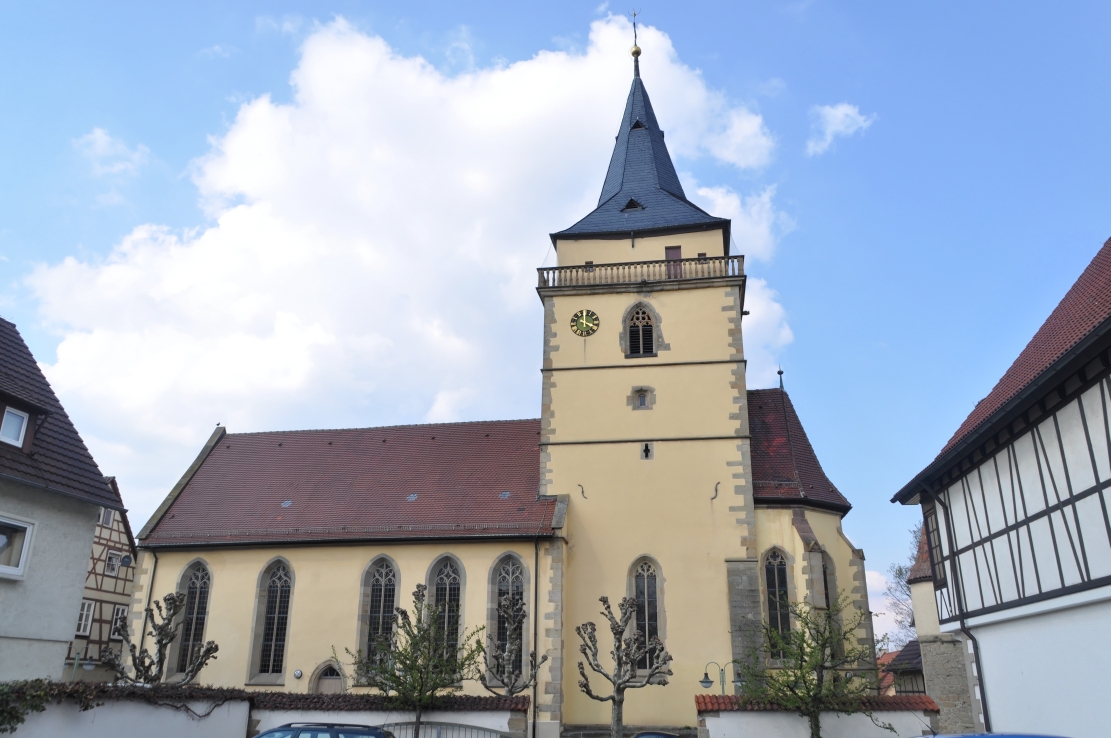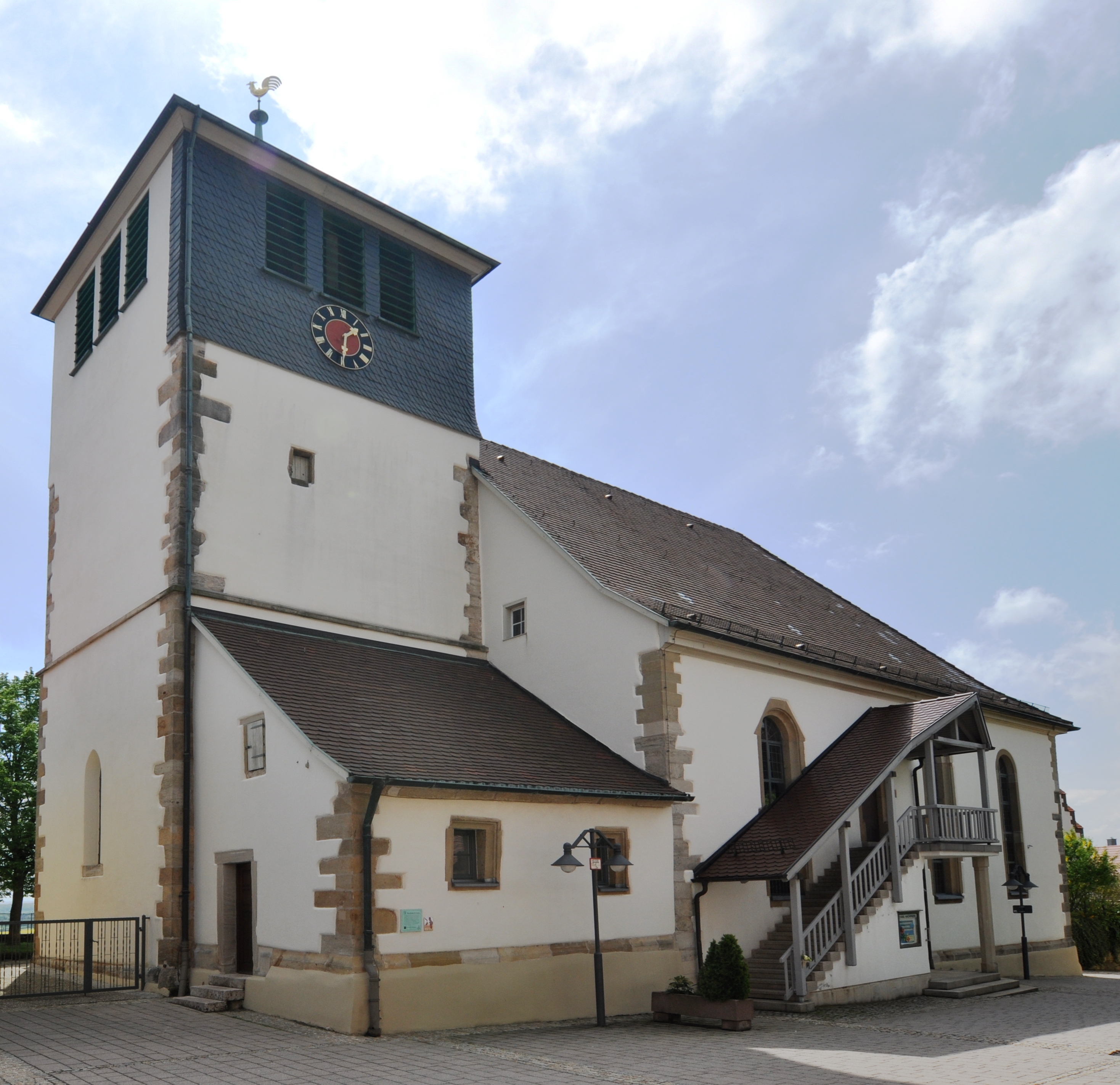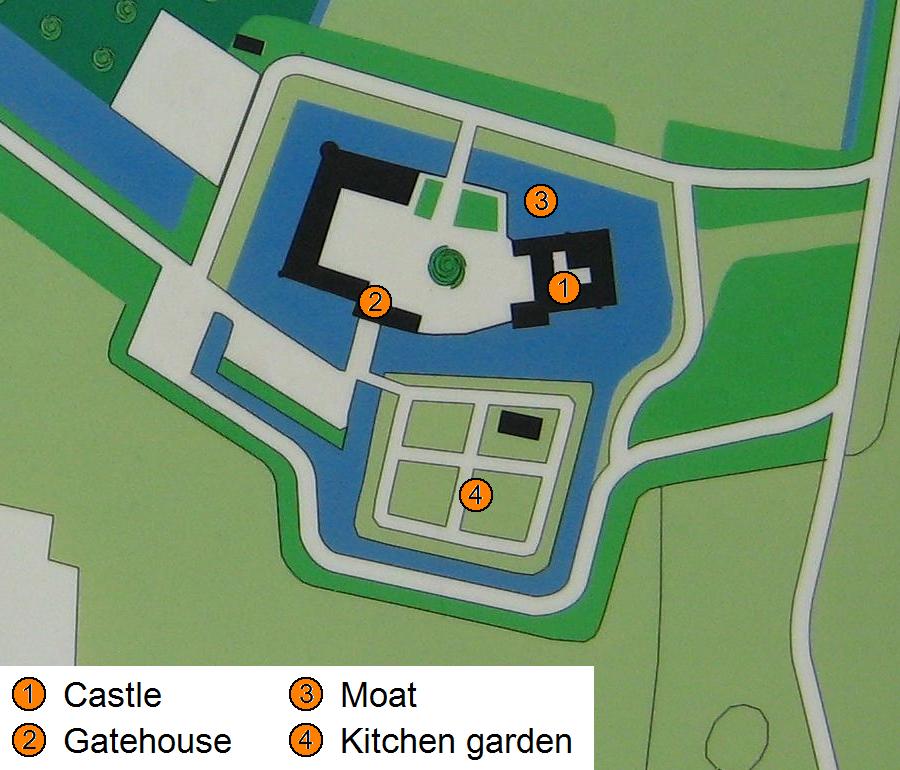|
Sachsenheim
Sachsenheim () is a town in the district of Ludwigsburg, Baden-Württemberg, Germany. It is situated 11 km northwest of Ludwigsburg. Buildings * The most important attraction is the water castle in Großsachsenheim. Built in the 14th century, burned down in 1542 and rebuilt in 1544. 1952 the castle was purchased by the city Großsachsenheim and is since 1962 the town hall. * Evangelische Stadtkirche "St. Fabian and Sebastian "in Großsachsenheim, former fortified church * Remains of the old city wall with tower * Evangelische Stadtkirche Kleinsachsenheim, former fortified church, rebuilt in 1460 and 1619, reconstruction 1948-1950 * Town hall Kleinsachsenheim, half-timbered building, first mentioned in 1614 * Parish Church "St. George "Hohenhaslach from 1230. Valuable early Gothic frescos * Village road Ochsenbach, half-timbered houses from the 16th to 18th centuries * Protestant parish "Our Lady" Ochsenbach, built around 1290, Gothic frescoes of 1430 * Evangelical churc ... [...More Info...] [...Related Items...] OR: [Wikipedia] [Google] [Baidu] |
Sachsenheim 2012-04 By-RaBoe-26
Sachsenheim () is a town in the Ludwigsburg (district), district of Ludwigsburg, Baden-Württemberg, Germany. It is situated 11 km northwest of Ludwigsburg. Buildings * The most important attraction is the water castle in Großsachsenheim. Built in the 14th century, burned down in 1542 and rebuilt in 1544. 1952 the castle was purchased by the city Großsachsenheim and is since 1962 the town hall. * Evangelische Stadtkirche "St. Fabian and Sebastian "in Großsachsenheim, former fortified church * Remains of the old city wall with tower * Evangelische Stadtkirche Kleinsachsenheim, former fortified church, rebuilt in 1460 and 1619, reconstruction 1948-1950 * Town hall Kleinsachsenheim, half-timbered building, first mentioned in 1614 * Parish Church "St. George "Hohenhaslach from 1230. Valuable early Gothic frescos * Village road Ochsenbach, half-timbered houses from the 16th to 18th centuries * Protestant parish "Our Lady" Ochsenbach, built around 1290, Gothic frescoes of 14 ... [...More Info...] [...Related Items...] OR: [Wikipedia] [Google] [Baidu] |
Württemberg Western Railway
The Western Railway (''Westbahn'') in Württemberg was opened in 1853 and ran from Bietigheim-Bissingen to Bruchsal. It was the first railway link between the states of Württemberg and Baden in Germany and one of the List of the first German railways to 1870, oldest lines in Germany. Formerly an important link line in national and international long-distance traffic, it has largely lost that role since the opening of the Mannheim–Stuttgart high-speed railway and primarily handles regional and goods traffic between the cities of Stuttgart, Karlsruhe, Mannheim and Heidelberg. Route In Bietigheim-Bissingen the Western Railway branches off from the Franconia Railway (Stuttgart–Heilbronn–Würzburg) in turning left and crosses the Bietigheim Enz Valley Bridge, Bietigheim Enz Valley Viaduct. After that it runs on the slope above the Metter river until it passes through a tunnel to reach Vaihingen (Enz) station. In Mühlacker station, Mühlacker, where the Karlsruhe–Mühlacker ... [...More Info...] [...Related Items...] OR: [Wikipedia] [Google] [Baidu] |
Ludwigsburg (district)
Landkreis Ludwigsburg is a ''Landkreis'' (district) in the middle of Baden-Württemberg, Germany. Neighboring districts are (from north clockwise) Heilbronn, Rems-Murr-Kreis, the district-free city Stuttgart, and the districts Böblingen and Enz-Kreis. History The district dates back to the ''Oberamt Ludwigsburg'', which was created by the dukedom Württemberg in the beginning of the 19th century. After several small changes during the century, it was converted into a district in 1938. Several municipalities of the dissolved ''Oberämter'' Besigheim, Marbach and Waiblingen were added to the newly formed district. As a result of the communal reform of 1973, the district gained about half of the dissolved district Vaihingen, and some few municipalities from the districts Backnang and Leonberg. Geography The main river in the district is the Neckar, which divides the district into a big western part and a smaller eastern part. Partnerships Starting in 1990 the district has a ... [...More Info...] [...Related Items...] OR: [Wikipedia] [Google] [Baidu] |
Baden-Württemberg
Baden-Württemberg (; ), commonly shortened to BW or BaWü, is a German state () in Southwest Germany, east of the Rhine, which forms the southern part of Germany's western border with France. With more than 11.07 million inhabitants across a total area of nearly , it is the third-largest German state by both area (behind Bavaria and Lower Saxony) and population (behind North Rhine-Westphalia and Bavaria). As a federated state, Baden-Württemberg is a partly-sovereign parliamentary republic. The largest city in Baden-Württemberg is the state capital of Stuttgart, followed by Mannheim and Karlsruhe. Other major cities are Freiburg im Breisgau, Heidelberg, Heilbronn, Pforzheim, Reutlingen, Tübingen, and Ulm. What is now Baden-Württemberg was formerly the historical territories of Baden, Prussian Hohenzollern, and Württemberg. Baden-Württemberg became a state of West Germany in April 1952 by the merger of Württemberg-Baden, South Baden, and Württemberg-Hohe ... [...More Info...] [...Related Items...] OR: [Wikipedia] [Google] [Baidu] |
Germany
Germany,, officially the Federal Republic of Germany, is a country in Central Europe. It is the second most populous country in Europe after Russia, and the most populous member state of the European Union. Germany is situated between the Baltic and North seas to the north, and the Alps to the south; it covers an area of , with a population of almost 84 million within its 16 constituent states. Germany borders Denmark to the north, Poland and the Czech Republic to the east, Austria and Switzerland to the south, and France, Luxembourg, Belgium, and the Netherlands to the west. The nation's capital and most populous city is Berlin and its financial centre is Frankfurt; the largest urban area is the Ruhr. Various Germanic tribes have inhabited the northern parts of modern Germany since classical antiquity. A region named Germania was documented before AD 100. In 962, the Kingdom of Germany formed the bulk of the Holy Roman Empire. During the 16th ce ... [...More Info...] [...Related Items...] OR: [Wikipedia] [Google] [Baidu] |
Ludwigsburg
Ludwigsburg (; Swabian: ''Ludisburg'') is a city in Baden-Württemberg, Germany, about north of Stuttgart city centre, near the river Neckar. It is the largest and primary city of the Ludwigsburg district with about 88,000 inhabitants. It is situated within the '' Stuttgart Region'', and the district is part of the administrative region (''Regierungsbezirk'') of Stuttgart. History The middle of Neckarland, where Ludwigsburg lies, was settled in the Stone and Bronze Ages. Numerous archaeological sites from the Hallstatt period remain in the city and surrounding area. Towards the end of the 1st century, the area was occupied by the Romans. They pushed the Limes further to the east around 150 and controlled the region until 260, when the Alamanni occupied the Neckarland. Evidence of the Alamanni settlement can be found in grave sites in the city today. The origins of Ludwigsburg date from the beginning of the 18th century (1718–1723) when the largest baroque castle in G ... [...More Info...] [...Related Items...] OR: [Wikipedia] [Google] [Baidu] |
Water Castle
A water castle is a castle whose site is largely defended by water. It can be entirely surrounded by water-filled moats (moated castle) or natural waterbodies such as island castles in a river or offshore. The term comes from European castle studies, mainly German ''Burgenkunde'', but is sometimes used in English-language popular science books and websites, and is mentioned in other more academic works. When stately homes were built in such a location, or a Wasserburg was later rebuilt as a residential manor, the German term becomes Wasserschloss, lit. "water palace/manor". Description Forde-Johnston describes such a site as "a castle in which water plays a prominent part in the defences." Apart from hindering attackers, an abundant supply of water was also an advantage during a siege. Topographically, such structures are a type of low-lying castle. Such a castle usually had only one entrance, which was via a drawbridge and that could be raised for protection in the event of ... [...More Info...] [...Related Items...] OR: [Wikipedia] [Google] [Baidu] |
Bundesautobahn 81
is a motorway in Germany. It branches off the A 3 at the Würzburg-West triangle and ends near the border with Switzerland. The oldest part of the A 81 between the Weinsberg Weinsberg (South Franconian: ''Weischberg'') is a town in the north of the state of Baden-Württemberg in Germany. It was founded around 1200 and is situated in the Heilbronn district. The town has about 11,800 inhabitants. It is noted for its win ... intersection ( A 6) near Heilbronn and Dreieck Leonberg ( A 8) near Stuttgart was finished in the years 1938 to 1940. This section included the first tunnel built for an autobahn, the first Engelberg tunnel near Leonberg. When Weinsberg-Leonberg was upgraded to 3+3 lanes in the 1970s, the tunnel with its two lanes each and steep grades (up to 6%) became something of a bottleneck. In 1999 a new Engelberg tunnel was opened. Original plans called for the A 81 to be continued northwards skirting the north-west of Würzburg to joi ... [...More Info...] [...Related Items...] OR: [Wikipedia] [Google] [Baidu] |
Christian Klar
Christian Klar (born 20 May 1952) is a former leading member of the second generation Red Army Faction (RAF), active between the 1970s and 1980s. Imprisoned in 1982 in Bruchsal Prison, he was released on 19 December 2008, after serving over 26 years of his life sentence. Early life The son of a teacher and vice-principal, Klar attended school in Lörrach, and in 1972 graduated from a school in Ettlingen. He went on to study history and philosophy at the University of Heidelberg, and became, for a while, a member of a young democratic movement. Around 1973 he moved to a Karlsruhe flat with his girlfriend Adelheid Schulz, Günter Sonnenberg and Knut Folkerts (who would all subsequently become RAF members) and in 1974 he took part in the occupation of the Hamburg Amnesty International offices protesting against the detention of RAF prisoners. Terrorism Around 1976, Klar joined the RAF and soon became a leading member of the second generation. Klar took part in the attempted kid ... [...More Info...] [...Related Items...] OR: [Wikipedia] [Google] [Baidu] |




